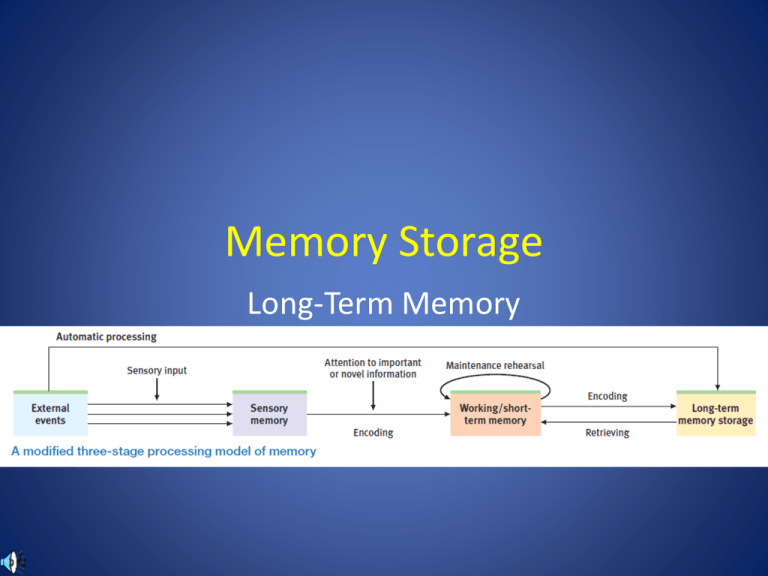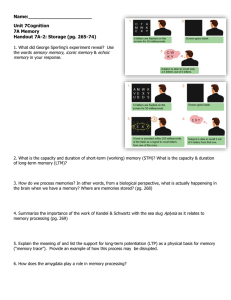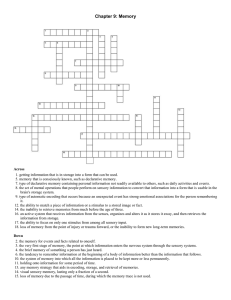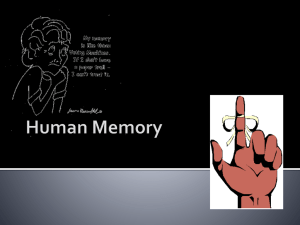Module 32: LTM & Biology of Memory PP Notes
advertisement

Memory Storage Long-Term Memory Long-Term Memory • Once information passes from sensory to working memory, it can be encoded into long-term memory Maintenance Rehearsal Encoding Sensory Input Sensory Memory Attention Long-term memory Working or Short-term Memory Retrieval Long-Term Memory • Function—organizes and stores information – more passive form of storage than working memory • Unlimited capacity • Duration—thought by some to be permanent Maintenance Rehearsal Encoding Sensory Input Sensory Memory Attention Long-term memory Working or Short-term Memory Retrieval Long-Term Memory • Encoding—process that controls movement from working (STM) memory to long-term memory storage (getting info in) • Retrieval—process that controls flow of information from long-term to working memory store (getting info out) Maintenance Rehearsal Encoding Sensory Input Sensory Memory Attention Long-term memory Working or Short-term Memory Retrieval Dimensions of LTM • Explicit memory—memory with awareness; information can be consciously recollected; also called declarative memory • Implicit memory—memory without awareness; memory that affects behavior but cannot consciously be recalled; also called nondeclarative memory Processing/Encoding leads to LTM Hippocampus Cerebellum Types of LTM Explicit/Declarative General Knowledge (semantic memory) Personal Events (episodic memory) Explicit Memories are easy to explain facts or experiences. Implicit Skills and Procedures (procedural memory) Conditioning (CC & OC) Implicit Memories are hard to put into words. They Involve skills and reactions we’ve learned. BIOLOGICAL BASIS OF MEMORY Biological Basis of Memory Karl Lashley searched for a localized memory trace or engram Believed that memory was localized – specific memory stored in a specific area. Removed parts of rat’s cerebral cortex but found no one area contained the memory of the maze Found that maze-learning in rats was distributed throughout the brain Memory and the Brain • Play “The Locus of Learning and Memory” (6:28) Module #16 from The Brain: Teaching Modules (2nd edition). • Watch first 3 minutes on Lashley’s Experiment and if time view Penfield’s experiment & why it was flawed. Biological Basis of Memory Richard Thompson Reflexive Behaviors are localized in the cerebellum • Thought that cerebellum was changed after classically conditioning a rabbit to blink to a tone. He was right! • Removing this area caused the rabbit to no longer blink to a tone but only reflexively. Shows localized memory. • This did not work for complex behaviors like running a maze, which seem to be distributed Brain Structures Involved in Memory Temporal Lobe • Includes: – hippocampus – Amygdala • Verbal information is stored in the left hippocampus and • Visual designs are stored in the right hippocampus Memory and the Hippocampus Memory and the Hippocampus • Damage to the hippocampus would result in the inability to form new explicit memories, but the ability to remember the skills of implicit memories •To view someone with this damage checkout the video by clicking on it (7:38) Implicit Memory Structures • Cerebellum – Stores procedural (muscle memory) skills – Riding a Bike, Swimming, Typing, playing an instrument • Basal Ganglia – Helps plan & control complex patterns of movement laying down a memory of the physical procedure. – Works without telling your consciousness (frontal lobe) Evidence for Separate Implicit/Explicit Systems • Neurophysiological evidence • Patient H.M. (Henry Gustav Molaison) – life-threatening seizures originating in temporal lobe – surgically removed portions of temporal lobe • Surgery was effective in reducing seizures • BUT, had other side effects as well • Can remember explicit memories acquired before the surgery – e.g., old addresses, normal vocabulary • Cannot form NEW explicit memories – e.g., remembering the name of someone he met 30 minutes prior – cannot name new world leaders or performers – can recognize a picture of himself from before his surgery but not from after and doesn’t recognize himself in a mirror • Click HERE for a video on H.M. (10 Min) – click the launch video button on this website to view. Patient H.M. • H.M. has severe explicit / declarative memory disorder • H.M. is almost normal on procedural or implicit memory tasks including priming, classical conditioning, and learning motor skills • When given the same procedural puzzle to solve for several days in a row, H. M. was able to solve the puzzle more quickly each day however, had no recollection of learning it. • This shows that explicit memory depends upon the Hippocampus and implicit does not Infantile Amnesia • • Infantile Amnesia – Inability to recall events from the first few years of life. Possible Reasons for this: 1. Too many differences between the world of an infant and ours for us to be able to make connections or retrieval cues to retrieve them (encoding specificity principle). 2. Hippocampus is still developing so they cannot form new LTM but they can make procedural memories. 3. One reason adults typically recall little of their first three years of life is that during infancy they were unable to verbally label most of their experiences (semantically encode the info). Emotions & the Amygdala • Amygdala may help in formation of emotional memories. Flashbulb Memory • A type of Episodic Memory • Memory of an event so surprising or significant to us that it is as if we photographed it in our mind. • Why do these happen? – We pay more attention to special events – We think about them more often (repetition) – We connect them to other events in our lives • Accuracy declines over time even though it feels extremely accurate Where were you on September 11, 2001? Memory and the Brain • Play “Remembering What Matters” (8:30) Segment #16 from Scientific American Frontiers: Video Collection for Introductory Psychology (2nd edition). • How does adrenaline affect our ability to remember something? • Which part of the brain seems to be active when you form flashbulb memories? • How do evolutionary psychologists explain flashbulb memories? New Memories in a Snail • Aplysia—a sea snail was used to study how memories can change neurons Eric Kandel Kandel’s Sea Snail Experiment • Eric Kandel – studied neural changes that took place in Aplysia, a sea snail. Click HERE to view it (4 min) • Squirted it with water followed by an electric shock that classically conditioned it to withdrawal its gills next time it was squirted. • This changed the three neuron circuit in the snail. Long-Term Potentiation – Neural change that occurs when you learn! • Function of the neuron changed: – increase in the amount of the neurotransmitter produced by the neuron. • Structure of the neuron changed: – number of interconnecting dendrites and axon terminals increased – receptor sites for neurotransmitters increasing allowing for more communication points (synapses). Long-Term Potentiation Memory Processing Review Figure 32.5 Our two memory systems David G. Myers: Myers’ Psychology for AP®, Second Edition Copyright © 2014 by Worth Publishers Aging and Memory • Ability to recall new information, unaided by clues, declines with age, • But ability to recognize new information, as in a multiple-choice question, does not. • Elderly may need more time to retrieve memories but still can do as well as a young person. Culture & Memory • Levy and Langer study of cultural views of aging show that society’s expectation that older people will have poorer memories can be a self-fulfilling prophecy. • In cultures where that is not believed (Asia) the elderly show memories just as good as the young. Misao Okawa of Osaka, Japan, was 117 when she died








